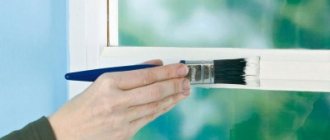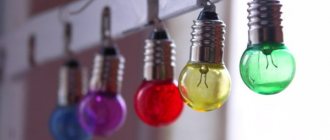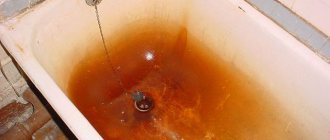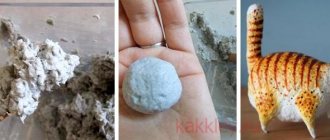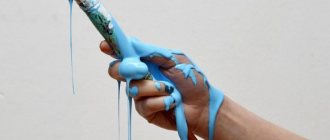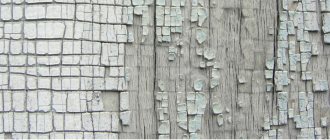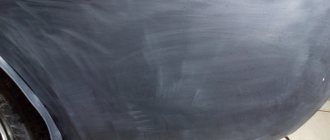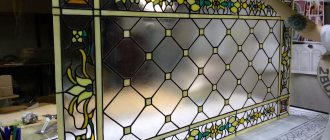Removing water-based paints
You can remove a layer of water-based paint at home in several simple ways, including:
- A combination of mechanical treatment with a brush with metal teeth and exposure to ordinary warm water. First, use a brush to leave deep scratches on the surface. Then we wet the roller in warm water and carefully treat the surface. We wait for 10-15 minutes until the paint swells and begins to peel off. Remove it with a metal scraper.
- Wallpaper glue. We take any sheet of paper, apply glue to it, and apply it to the paintwork. We wait until the glue dries. Then remove it using a spatula.
Features of the composition
Acrylic paint is applied to various surfaces, including:
- tree;
- fabrics;
- plastic;
- concrete;
- brick;
- glass.
During construction and renovation, multifunctional coating is used for both external and internal work. The choice of paint color is practically unlimited. In addition, it does not flow down on vertical planes, fits well, and does not form any streaks or unevenness.
Nitrosolvents
Pour a small amount of thinner into the jar (it should penetrate the bristles of the brush; this can be helped by pressing the brush against the side of the jar). Leave the brush for 2 hours and dry with a clean cloth. Store in a dry place until further use.
Read also: pastel blue IN COLOR BALANCE
Thinner should not be poured into the sink. After cleaning the brushes, close the jar with a lid and leave it for 24 hours. Once the washed-out paint has settled to the bottom, pour the remaining solvent into the bottle for later use. Wait until the residue at the bottom is completely dry, then throw it away. Try using the smallest can, therefore the smallest amount of thinner – the planet will thank you!
If the wallpaper is stained
Was the wallpaper damaged while painting the baseboard, floor, doors or ceiling? In this case, it is possible to correct the situation if the paint has not yet dried. How to remove paint from wallpaper? The best option is to immediately blot the stained area with a damp sponge and leave until dry.
Vegetable oil can also help remove paint from wallpaper - to do this, soak a clean cloth in oil, apply it to the stain for a while, and then remove it with light blotting movements.
It is almost impossible to remove dried paint from wallpaper without damaging it. The solution to the problem will be to replace the stained section of wallpaper or skillfully decorate the walls to hide the repair misunderstanding.
Should you wash your brushes with soap? Of course yes
Probably the most common method for washing brushes . After all, soap easily washes your hands of grease (natural or artificial oils). Absolutely any solid soap will do. If anyone is interested, the less dye and different flavors in the soap, the more natural it is, but I think this can be omitted. Our main task is to wash the brushes .
Mode of application:
Take the soap in one hand, and the other brush, moisten it and the soap with running water. After this, we begin washing in a circular motion, moving the brush over the surface of the soap until foam forms. At this moment, the paint is washed away from the brush bristles . Rinse the brush with water and repeat until the brush is completely clean.
In art stores you can find soap for cleaning brushes .
Avoid white spirit
Some people use white spirit as a remover for oil paint, but there are much safer products for both you and the environment. A worthy alternative to white spirit is “clean” alcohol; we use Bartoline Clean Spirit. The cleaning principle is exactly the same as in the case of traditional white spirit. But please do not pour the solution down the drain afterwards. Pour the dirty "wash" alcohol into an empty container. Over time, the pigment will settle to the bottom, and reusable pure alcohol will remain on top.
The best solution for cleaning oil-based paint from brushes is natural oil. The only disadvantage of this method is that it will take a little more time. Flaxseed oil tends to dry out quickly, so walnut oil or safflower oil are better alternatives. Our choice fell on the brush cleaning kit with walnut oil from Terlans. The kit contains: paint thinner, water-based cleaner and slow-drying oil. If you still decide to use a thinner, buy odorless white spirit in specialized art stores.
Cleaning instruments during a long break
If the break between stages of painting work is longer, at least one day, the brushes need to be cared for differently. After painting, leaving them in a jar of solvent for a day is not the best method, since it can lead to deformation of the pile, which will make the subsequent painting process impossible. Therefore, you will have to wash the instrument according to all the rules using special products. If you do not have a professional brush cleaner, prepare the following set of accessories:
- any paint solvent;
- disposable paper towel or piece of soft rag;
- regular laundry soap;
- A container deep enough to immerse brushes.
To thoroughly wash your brushes after painting and ensure proper care for them, you should follow several steps:
- Pour a sufficient amount of solvent into the container.
- Place the brush in the product with the nap facing down and thoroughly soak the lint.
- After this, remove the brush and dry it thoroughly using a rag or paper towel.
- Then the bristles of the products should be thoroughly smeared with soapy foam and washed under running water for several minutes.
All these steps should be repeated until the pile is completely free of paint and varnish materials. This method of care allows you to thoroughly wash the paint, even if it has dried.
Depending on the type of paint used, you need to wash your brushes with different types of solvents. Paints and varnishes that have a water-soluble or adhesive base can be washed with plain water.
And if you have to wash your brush after using oil paint, you should use a special mineral solvent.
Due to the fact that brush cleaning liquid and solvent are products that have a very strong and specific odor, it is advisable to wash these products on the balcony or in the open air. After the procedure is completed, the brush must be thoroughly dried by placing it in a vertical position with the bristles facing up.
Brussels manicurius
The look is simple, the class is creative. Consists of 3 parts: bristles, clip and handle.
- Bristle. Hair can be natural or synthetic. Choose the one that your wallet allows you to take. Artificial bristles are in no way inferior in quality to natural bristles if the brush is made to last. Synthetics of the newest generation, sometimes, cope better with the assigned tasks and are distinguished by good durability and strength. The bristles must be soft and elastic; hard and hard bristles will not allow you to apply nail polish sparingly and draw patterns.
- Clip. Funny name for the iron clamp connecting the bristles to the handle. It must be strong and tightly compressed, which will protect the hairs from falling out during work and prevent the brush from fluffing up.
- Pen. Doesn't affect anything other than cost. Wood or plastic. Status or economy.
The arsenal of a real pro includes controversial brushes:
- Wide and medium with an oval tip for base and finish.
- Narrow “needle-shaped” ones for painting.
- With a beveled tip for creating a French manicure.
- Fan, thin and many others for Chinese painting, creating a gradient and other whims of fantasy.
Naturally, these are general tips. Each master decides for himself which form to choose for work. Convenience comes first. Regardless of shape, size and material, brushes must be carefully cleaned every time. A real pro knows how to carefully clean any brush from gel polish so that it serves faithfully for a long time. Especially if it is financially expensive.
What types of brushes are used during painting work?
Every person who has at least once carried out renovations in an apartment on their own is well aware that in order to perform high-quality work, several different types of brushes are required. Thus, priming surfaces, painting ceilings and walls of a room using water-soluble acrylic products requires the use of large flat brushes. For working with oil and some other types of paints, small round or flat brushes, called flutes, are quite suitable.
Types of brushes
In any painting process there are certain breaks, during which the functional properties of the brushes must be preserved in their original state - this will help avoid the need to purchase a new product and save you money and time.
General recommendations
Blot excess paint with a cloth or soft napkin. For greater effectiveness, you can gently squeeze the hairs with your fingers or a cloth in the direction from the cartridge to the ends, being careful not to pull them. If you painted with oil paints, rinse your brush in turpentine or oil. When using water-soluble pigments, warm water will be sufficient. Never use hot water. This will cause the cartridge to expand, causing hairs to fall out. Blot the brush again with a cloth, removing any remaining paint. Rinse the brush carefully in a mild solution of soap or dishwashing detergent. Lightly rub the lint with a bar of soap, then work the foam onto a surface or your palm if you are not using any toxic solvents or pigments. Rinse the hairs and repeat until the dye of any color stops washing out. Over time, your brush will get dirty, but don't stop rinsing it until you're sure it's clean. Don't use brute force. Be patient and rinse the brush several times. Rinse off any remaining soap with warm water. Shake off moisture from the pile. Try to give the hairs the desired shape with your fingers. If necessary, wrap the wet brush in a napkin or toilet paper. As the paper dries, it will shrink, giving the stubble the desired silhouette. Leave the brush to dry at room temperature
Please note that it should not stand with the pile down, otherwise the form will be damaged after drying. Place the brush horizontally or vertically on the tip of the handle
You shouldn't dry too many brushes together so that they don't get crowded. If you are concerned about the toxicity of the paint you are using, or if it stains your hands while washing, wear gloves. You can also try the Bob Ross Painters Glove.
Completion of painting work
Brushes must be cleaned thoroughly if the color of the paint changes or the repair has come to an end, and it is a pity to throw away the tool. After removing the excess paint composition into a jar, clean the pile on an unnecessary piece of board or plywood; a piece of thick rag will also do.
Remove dried paint on the handle and from the metal base near the pile using a brush or any other metal tool . If the pile is dense, fluff it slightly. Wash in white spirit or other solvent. Dilute soap in hot water and rinse the brush.
Important: dry washed brushes with the pile facing up or hanging so that the bristles do not bend.
There are tips for removing stuck paint from pile with vinegar. It is recommended to soak the brush in acid for several hours; if this does not help, then boil it in vinegar over low heat. It should be remembered that when boiled, vinegar releases volatile substances that are dangerous to the human respiratory tract. In this case, the risk of harm to health outweighs the practicality of cleaning the brush.
Special brush washer
This is a container in the form of a small saucepan with a spring soldered to it on top. Thinner is poured inside, and the brush is fixed in the spring so that its bristles are completely immersed in the product. After cleaning, you can store the brush in the brush tray, but then you add oil instead of solvent. Sunflower or flaxseed will do.
To keep the bristles of the brush soft, it is enough to immerse only the ends of the bristles in the oil.
How to remove fresh acrylic paint stains
As soon as a stain appears (less than 60 minutes have passed) on any surface, wash it off with a sponge soaked in a warm soapy solution. Treat the stained area with smooth movements without pressure, starting from the edges and moving towards the center of the stain. After removing marks on clothing, immediately wash the item as usual.
A sponge with soap is the most effective remedy for liquid acrylic paint.
To clean your brushes from acrylic paint, immediately after finishing your work, immerse them in warm water and leave for 20 minutes. Then rinse under running water and dry in the sun.
1.2. Using fabric softener
The cleaning procedure is as follows:
- prepare a cleaning solution from 120 ml of conditioner and 4 liters of water;
- remove paint residues with a paper towel or cloth rag;
- wash thoroughly in the prepared solution;
- by shaking or using paper or fabric waste, remove any remaining solution;
- straighten and dry the brush bristles.
Other methods
There are other time-tested brush care methods that are very effective. If the paint has not completely dried to the pile, you can wash it using regular fabric softener:
- When starting the procedure, you need to wipe off the excess paint with a soft cloth.
- Then mix conditioner and warm water in equal parts.
- Wash the brush thoroughly in the solution until the paint begins to gradually slide off.
- To consolidate the result, continue to wash the product in warm running water.
- When there are no traces of paint left, the product needs to be thoroughly dried by placing it in a small jar with the nap facing up.
If the paint is too dry, try another method:
- Pour the required amount of vinegar into a convenient container, for example a glass one, and place the brush there for one hour.
- When this period has passed, check how much the paint has softened.
- If the paint has not softened enough, leave the brush in this position for another hour.
- The next step is to take an old saucepan, unsuitable for food purposes, and pour vinegar into it.
- Then place the brush in the pan, place it on the stove, set the flame to medium and wait until it boils.
- The contents of the vessel should continue to boil for several minutes.
- Next, remove the cleaned brush and carefully comb its bristles using a metal brush.
- It is necessary to comb the brush until the smallest particles of paint are completely separated from the bristles.
- Finally, the product should be rinsed in running water and left to dry in a vertical position with the pile facing up.
Regardless of the cleaning method, proper brush care requires moistening the bristles. Any cosmetic conditioner or lotion will be suitable for these purposes. Proper storage of brushes also plays an important role and helps to preserve their properties for as long as necessary.
